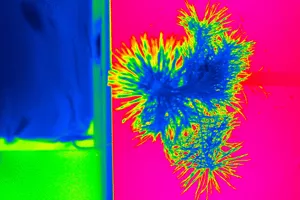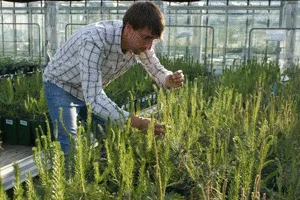Module 3 STRESSORS


Adressed key deliverable: To set up manipulative experiments of extreme events (heat, drought, flood) in order to properly describe the linkage of physical event impacts on selected fitness and growth parameters as well as stress indicators. Module 3 uses seedlings and young trees of European tree species represented each by up to 10 provenances. Objectives:
- To establish extreme event experiments in glasshouses, common gardens, and open field sites at internal and external margins (WP 3.1)
- To measure impacts on plant fitness, growth and survival (WP 3.2)
- To develop a set of possible stress indicators in the fields of BVOCs and isotopic relations (WP 3.3)
Extreme event experiment in TUM Dürnast glasshouse facilities
During the last two decades, severe drought induced forest diebacks and damages were observed in Europe. Also future climate scenarios predict an increase of severe drought events. However, whether carbon starvation or hydraulic failure - the reasons for tree dieback under drought conditions are not fully understood yet. The E3 drought and passive warming experiments are based at the TUM GHL facilities, inside different glasshouses and outside with rainout shelter and open field heating system.
In the current experiment 10 different Scots pine provenances (240 individuals per provenance, 2400 3-year-old plants in total) are studied under two temperature regimes (ambient in vegetation hall, elevated in greenhouse) and four moisture regimes (seasonal droughts in spring and/or summer 2013). In 2014 we will study Quercus petraea, Castanea sativa and Pinus sylvestris.
Extreme event impacts on plant fitness, growth and survival
A large set of response variables in the fields of phenology, morphology and ecophysiology is measured and assessed, a. o. survival and
- Phenology: onset of different phenophases such bud burst or start of unfolding needles
- Morphology: stem height, diameter, architecture, and needle length
- Ecophysiology: chlorophyll-fluorescence, needle surface temperature by thermal imaging, drought related proteins & carbohydrates, carbon-isotope-ratios, and nutrients in needles.
TREE DEMON – the tree drought emission monitor
Especially young tree seedlings are more prone to drought stress events since their metabolism has fewer resources to survive long or extreme stresses and afterwards to regenerate – therefore the gap between life and death is small (Niinemets, 2010). Thus, non-destructive methods of monitoring the different stress levels are important to select proper tree species and suitable provenances. E3 developed TREE DEMON, the tree drought emission monitor for the non-invasive measurement of biogenic organic volatiles (BVOC), photosynthesis and transpiration in a dynamic plant chamber system. It is used at the end of the drought / warming stress experiments at TUM GHL in order to
- measure BVOC emissions for assessment of stress levels
- detect „points of no return“ of plants by BVOC emission and pattern
- compare performance based on BVOC, photosynthesis, and transpiration.